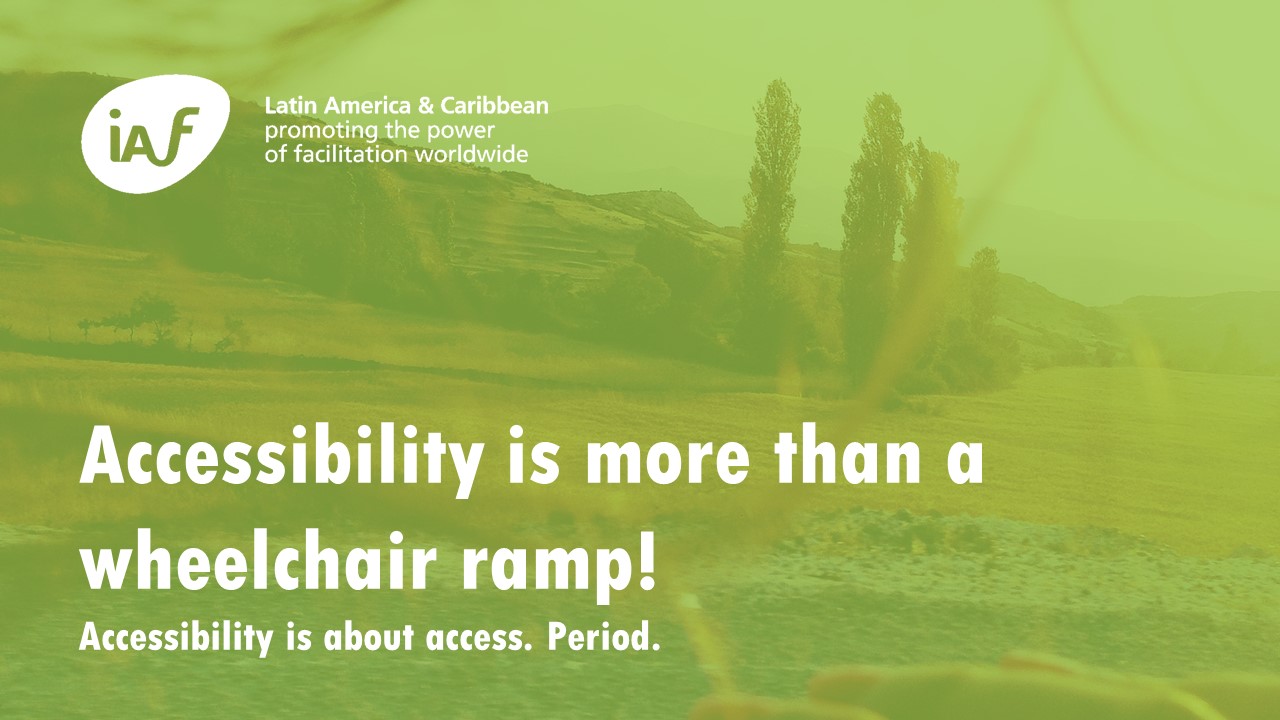Global Flipchart #16
September 2019
Accessibility is more than a wheelchair ramp

Melissa A. Matthews
Accessibility is at its core about access.
access
/ˈaksɛs/
Noun
the means or opportunity to approach or enter a place.
What does this mean as it relates to facilitation?
By mid to late 2015, my business partner and I had garnered several large scale facilitation and capacity-building projects, mainly for major corporate social responsibility programmes sponsored by large privately-held companies in Trinidad. We were riding high. Our reputation was growing and word was spreading. After every workshop, there was an influx of inquiries from groups interested in attending. However, the problem was that we often worked at the bidding of our clients. They were large corporations that handpicked NGOs and community groups to attend their trainings based on their areas of interest (the fenceline communities they served). It did not lend itself to accommodating groups without sponsorship or outside of our clients’ interest.
After fielding what seemed to be an endless stream of requests for about a year, we launched Agitate Academy. This was our own affordable training solution branded and targeted to low-resource, non-governmental/non-profit organisation (NGO) and community-based organisations (CBO). It became the entity under which we’ve been able to increase the physical accessibility of our facilitation and training by 100%.
Agitate Academy started as a semi-annual training programme tackling basic NGO and CBO management and capacity in late 2015. To date, we have worked with over 120 organizations through the programme and it has morphed to include online and email courses. More recently in 2017, we launched an empowerment through entrepreneurship camp for girls. As a part of the setup for camp, we conducted facilitator training for our staff. Word spread about that training and we have been able to expand it to include non-prospective employees, corporate and NGO teams, etc. Although both of these examples highlight very real instances of accessibility, in this context, it is what I refer to as “wheelchair ramp accessibility” —a way in or an open door for those interested.
Once we open a door, we have to recognize that accessibility is about more. It is about meeting participants where they are, validating their life experience, helping them to construct a safe space within a facilitation space. Participants should feel seen, heard, and understood within the confines of any effective facilitation. This assertion begs the question:
How do we achieve this type of layered/nuanced accessibility?
In my practice, this has meant being intentional in the crafting of content for facilitation. Every training or facilitation session has clear objectives, but they do not exist in a vacuum. When creating or cultivating a facilitation plan, one must first do reconnaissance on who will be in the room. Whether it is a survey or a profile provided by the client. Having a baseline understanding of who you are guiding through a process allows you to cater the material to reflect and include them.
Human beings tend to be more engaged when they feel seen. If working with people in a particular region/country, make the extra effort to include examples or references to local culture throughout your process. This should be evident from a planning perspective.
Once in a room, establishing an environment of full participation and engagement relies on what you do in the first ten to fifteen minutes of your session.
First impressions are lasting.
- First things first, demonstrate respect. Get acquainted with participants’ names by making an effort to look at and use their names when addressing them if they are wearing name tags.
- Secondly, illustrate participation and ownership—set the pace. Present an activity that allows people to dig deeper than surface “HELLOs,” at the start of a session. Establish a community agreement. Let every person present contribute to a document outlining how you all engage with each other in that space. Once complete, have everyone sign it. This serves as an accountability and community-building measure in one. It builds rapport with you as a supporting guide to the process, creates buy-in and stewardship of the space by participants.
- Thirdly, leave minor gaps in your agenda to allow for organic conversation and flow. If your facilitation is or feels rushed, participants will shutdown. There has to be enough space to explore the inevitable organic dialogue that occurs when people come together for a common cause. This off-script chatter can sometimes inform the facilitation beautifully, when done correctly. Be mindful not to engage in outlandish cross talk or tangents by gently keeping the group focused, but allowing them to share their life-experience on the topic at hand. This also works in helping folks to work through blocks by listening to others’ difficulties or questions. Do not underestimate the principle that every person brings value into the facilitation process and their contributions should be valued.
- Above all else, the key to sustainable accessibility in any facilitation space is the value placed on feedback. It is a conversation between the participant and the facilitator which reveals how they want to be seen, heard, and/or understood. Therefore, one must not only accept, but internalize constructive criticism and feedback—lean into it.
“I believe in accessibility. I believe in honesty and a culture that supports that. And you can't have that if you're not open to receiving feedback.”
—Mindy Grossman